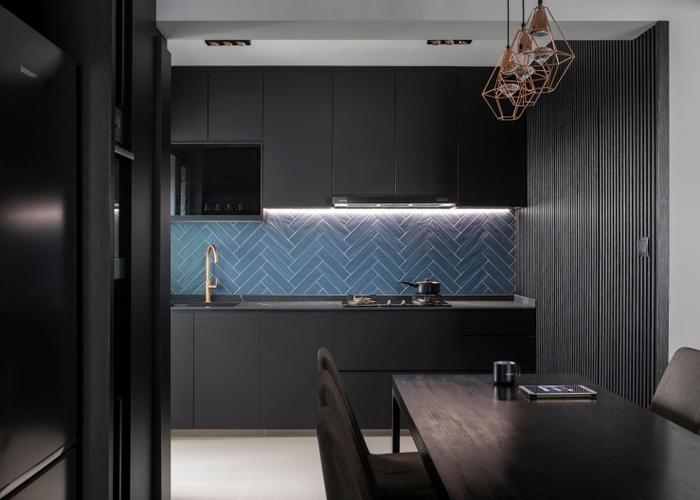From why it’s necessary to choosing the right one.
The kitchen is one of the most hardworking places in the home, which is why planning out the space will go a long way in increasing its efficiency.
That said, kitchen countertops and kitchen cabinetry are always in the spotlight (which is understandable given that these installations should match design and lifestyle needs) but a kitchen backsplash should not be glossed over. Today, we answer all your pressing questions about it.

View this project by Ethan Interiors
1. What is a kitchen backsplash and is it necessary?
First things first: a kitchen backsplash is a vertical panel installed behind your work stations (i.e. your sinks and cookers). It usually covers the area of the wall between the countertop and cabinets, but can be extended as high as the ceiling.

View this project by IS Design Studio
As a space that sees loads of spills, grease splatter and is quite humid, kitchen walls can become quite damaged over time. The purpose of the kitchen backsplash is therefore to protect them from deterioration and ease maintenance efforts but has recently become an added focal point for homes.

View this project by Design 4 Space
2. When should kitchen backsplashes be installed?
As a general rule of thumb, backsplashes should be installed after your countertop is fixed up (especially in the case of granite and solid surfaces). The reason being that there’s a need to grout (where applicable), seal and caulk to really prevent water from seeping into any hairline cracks and causing mould growth.

View this project by Urban Home Design 二本設計家
3. What's the best kitchen backsplash material to use?
Some materials used for backsplashes include tempered glass, tiles, solid panels, quartz, sintered stone and stainless steel. Needless to say, they all have their pros and cons.

View this project by Studio CS
Tempered Glass

View this project by Yang's Inspiration Design
| Pros | Cons |
|
|
Tiles

View this project by Place to Relax
| Pros | Cons |
|
|
Solid Panels

View this project by ProjectGuru
| Pros | Cons |
|
|
Quartz/Sintered Stone

View this project by GoDesign
| Pros | Cons |
|
|
Note: While the two materials may look similar, there are nuanced differences between the two. Read this guide for a deep-dive comparison on the differences between quartz and sintered stone.
Stainless Steel

View this project by Glamour Concept
| Pros | Cons |
|
|
4. Are there any tips for matching the backsplash with the rest of the kitchen?
Assuming that you have found your overall style, you should start pinning some ideas and picking your colours. Consider the size of your kitchen when doing this – lighter colours can visually widen the space.

View this project by Third Paragraph
While dark colours can make the kitchen feel warmer.

View this project by Four By Eight Design Studio
After narrowing down your choices, order samples or head down to showrooms to have a look and feel in person.

View this project by Insight.Out Studio
Consider your countertop and cabinet colours before you settle on one. There’s also a more updated trend where people match and repeat patterns in other areas of the kitchen such as the floor or island.

View this project by Ofthebox
Depending on your home’s overall palette, you can use your backsplash to juxtapose for a standout look.
Explore: Kitchen backsplash design ideas
5. Which kitchen backsplash material is the easiest to clean and maintain?
Textured or tiled backsplashes generally require more thorough cleaning compared to the other materials listed above. This is because the presence of crevices/grout lines means that the surface isn’t smooth/even, serving as recesses for scum to accumulate.

View this project by DC Vision Design
So, if you like the look of tiled backsplashes, consider getting larger format tiles that require fewer grout lines.
That said, all backsplashes regardless of material should be wiped down either after each session of heavy cooking, or at least once a week to prevent the buildup of scum, grease and watermarks. Do also check with your material supplier on the types of cleaning agents that can/cannot be used for each surface, or use gentler cleaning agents (such as plant-based ones) if you’re unsure.

View this project by Space Atelier
Special thanks to the professionals at Synergraphic, Hafary and Para.graph for their insights.
Makeover your kitchen!
But of course, it’s also important that you consult a professional on the best backsplash to get for your kitchen based on your lifestyle needs and how the rest of your interior will look like.
Request for a quote to get a personalised list of interior design firms for free!
Plus, renovate with a peace of mind when you engage an interior firm with us. Safeguard up to $50,000 of your renovation deposits under the Qanvast Guarantee.
(This article was first published on 30 May 2019 and last updated on 12 April 2024.)

 Get a budget estimate before meeting IDs
Get a budget estimate before meeting IDs